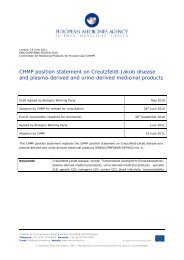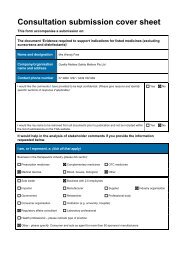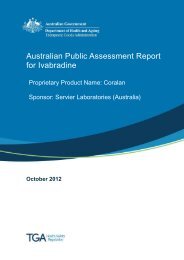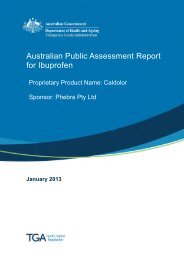AusPAR: Clobetasol propionate - Therapeutic Goods Administration
AusPAR: Clobetasol propionate - Therapeutic Goods Administration
AusPAR: Clobetasol propionate - Therapeutic Goods Administration
You also want an ePaper? Increase the reach of your titles
YUMPU automatically turns print PDFs into web optimized ePapers that Google loves.
<strong>Therapeutic</strong> <strong>Goods</strong> <strong>Administration</strong>CPSH was non-inferior to clobetasol <strong>propionate</strong> 0.05% gel for the treatment of scalppsoriasis. In Study RD.03.SRE.2665, non-inferiority was demonstrated in the per-protocolpopulation and confirmed in the ITT. The 95% CI for the difference in treatments inchange in Total Severity Score from baseline (Dermoval - CPSH) was 0.25 to 1.29 for theper-protocol population and 0.24 to 1.34 for the ITT. However, for some of the secondaryefficacy outcome measures, clobetasol <strong>propionate</strong> 0.05% gel was superior to CPSH (StudyRD.03.SRE.2665).CPSH was superior to Calcipotriol solution 0.005%, (Dovonex/ Daivonex), twice daily,and to Polytar®. In Study RD.03.RDE.2638, non-inferiority was demonstrated on the perprotocolanalysis of Total Severity Score and superiority was demonstrated on thesecondary analysis of the ITT population. The 95% CI for the difference in Day 28 TotalSeverity score (CPSH – calcipitriol) was -0.66 to 0.18 for the per-protocol analysis and-0.97 to -0.05 for the ITT analysis. In Study RD.03.SRE.2648, non-inferiority wasdemonstrated in comparison to Polytar® in the per-protocol population by the predefinedcriteria. The mean (95% CI) for the difference in Total Severity score at Week 4 (Polytar®- CPSH) was -2.066 (-2.727 to -1.405) and the upper 95% CI was below the non-inferioritytarget of 1.5. Superiority was demonstrated by the secondary analysis of Total Severityscore in the ITT population. The mean (95% CI) for the difference in Total Severity scoreat Week 4 (Polytar® - CPSH) was -1.842 (-2.475 to -1.208), p = 0.0001.In addition, Study 1.CG.03.SRE.2591 supported the administration method of 15 minuteapplication to dry hair followed by lathering and rinsing.First round assessment of risksShampooThe risks of CPSH in the proposed usage are:• Increased risk glaucoma and raised intraocular pressure• HPA axis suppression• Cushing’s syndrome• Local reactions: burning and stingingThere were slightly more AEs reported with CPSH than with vehicle with the excessappearing to be related to skin discomfort (Study RD.06.SRE.18076).There were significantly fewer subjects reporting AEs with CPSH than with calcipotriol:10.5% compared with 30.7% respectively (Study RD.03.RDE.2638). However, there was ahigher proportion of subjects with AEs in comparison with Polytar®: 22.5% comparedwith 12.5% respectively, with the excess appearing to be due to skin discomfort andheadache (Study RD.03.SRE.2648).There were few SAEs, none attributable to study treatment, and no deaths reported in thestudies of CPSH. Discontinuation due to AE was uncommon.CPSH had good dermal tolerability. It caused slight irritation only and was not a sensitiser.There were few abnormal laboratory test results, and none attributed to CPSH but formost of the studies routine laboratory tests were not performed.Exposure to Clobex® shampoo in accordance with the instructions in the PIis unlikely tolead to significant systemic exposure to clobetasol <strong>propionate</strong>.The shampoo formulation appeared to have less potential for HPA axis suppression butone subject did have evidence of HPA axis suppression and treatment emergenthypertension (Study 1.CG.03.SRE.2620 and Study RD.06.SRE.18070).<strong>AusPAR</strong> Clobex clobetasol <strong>propionate</strong> Galderma Australia Pty Ltd PM-2011-01596-3-5Final 22 May 2013Page 29 of 45
















